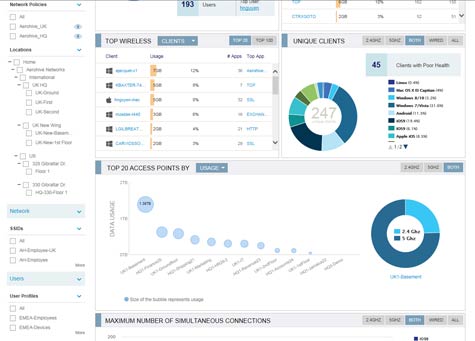2016 Trends: Preparing the Network for Web-Scale Demands As the devices attached to wireless networks become more robust, the richer the applications they begin to consume become. Before long many IT organizations discover that the first generation of wireless networks they deployed are no longer capable of meeting the bandwidth demands of those applications. Aerohive […]

2016 Trends: Preparing the Network for Web-Scale Demands

As the devices attached to wireless networks become more robust, the richer the applications they begin to consume become. Before long many IT organizations discover that the first generation of wireless networks they deployed are no longer capable of meeting the bandwidth demands of those applications.
Aerohive Networks this week unveiled two new cloud-managed 802.11ac Wave 2 access points, the AP250 and the AP245X. The AP250 access point’s software-selectable radios allow administrators to select transmission at 2.4GHz and 5GHz or to select dual 5GHz. Abby Strong, director of product marketing for Aerohive Networks, says for now IT organizations will need to support a mixed class of mobile computing devices that only require 2.4GHz. But over time most organizations will need to move to 5Ghz. The AP250 and AP245X indoor and outdoor access points are designed to protect investments in access points through that transition, says Strong.
In addition to the access points, Aerohive Networks this week also unveiled four switches that, like the access points, can be managed via a HiveManager NG cloud application hosted by Aerohive Networks or, as of this week, hosted on a private cloud managed by an internal IT organization. Strong says the goal is to provide IT organizations multiple options for using a common pane of glass to manage both their wireless and wired networking environments. The private cloud instance of HiveManager NG, however, is limited to managing 20,000 access points.

Due to the rise of mobile computing, the wireless network in most organizations is now the primary means through which most end users are accessing applications. For IT organizations, that not only creates a management challenge, it also means that the perception of the competency of the IT organization is most often tied to the robustness of its wireless network. Regardless of how challenging the physical dimensions of the office space might be, for end users who have a poor mobile computing experience, the assumption is going to be that the internal IT organization is simply not up to the task.
Given the quality of the radio antennas installed in any given mobile computing device, that perception may not be entirely fair. Nevertheless, those perceptions will start to manifest themselves in end-user satisfaction surveys, holding IT organizations accountable regardless of what the actual IT reality might be.
MV
Michael Vizard is a seasoned IT journalist, with nearly 30 years of experience writing and editing about enterprise IT issues. He is a contributor to publications including Programmableweb, IT Business Edge, CIOinsight and UBM Tech. He formerly was editorial director for Ziff-Davis Enterprise, where he launched the company’s custom content division, and has also served as editor in chief for CRN and InfoWorld. He also has held editorial positions at PC Week, Computerworld and Digital Review.










